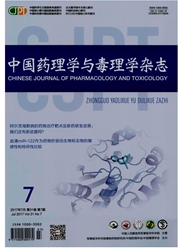

 中文摘要:
中文摘要:
目的 探讨DNA损伤剂2-乙酰氨基芴(2-AAF)是否可诱导γH2AX焦点的形成及γH2AX作为检测DNA损伤的一个新的特异指标的可能性。方法 用2-AAF处理中国仓鼠CHL细胞,应用免疫荧光方法检测γH2AX焦点的形成,并通过中性彗星实验验证DNA损伤的程度。结果 0.1,1,5和20mg·L^-1的2-AAF都可使细胞核内γH2AX焦点数量及有γH2AX焦点生成的细胞数量增加,但只有20mg·L^-1 2-AAF处理的细胞才出现明显的彗尾增长及有彗尾的细胞数量增加。另外,磷脂酰肌醇3-激酶(PI3K)家族抑制物渥曼青霉素可抑制2-AAF诱导的γH2AX焦点形成。结论 2-AAF可通过激活PI3K家族成员使H2AX磷酸化,进而诱导TH2AX焦点的形成。γH2AX检测DNA损伤的敏感性优于彗星实验,因此,γH2AX有可能成为衡量DNA损伤程度的良好指标。
 英文摘要:
英文摘要:
AIM To investigate whether 2- acetylaminofluorene ( 2-AAF ) can induce γH2AX foci formation, and whether γH2AX can be used as an indicator for detecting DNA damage. METHODS 2-AAF-induced γH2AX foci were detected by immunofluorescent microscopy; neutral comet assay was also employed to detect the DNA double strand breaks ( DSBs ). RESULTS γH2AX foci were induced by 0.1 , 1, 5 and 20 mg·L^-1 of 2-AAF in CHL cells in a time-dependent manner. However, neutral comet assay only revealed DNA damage at 20mg·L^-1 of 2-AAF treatment. In addition, the phosphatidylinositol 3-kinase (PIK) family inhibitor wortmannin inhibited the formation of γH2AX in CHL cells.CONCLUSION 2-AAF induces γH2AX loci formation, and PI3K family members were responsible for the phosphorylation of H2AX. In addition,γH2AX foci formation is more sensitive in detecting DNA damage than neutral comet assay.
 同期刊论文项目
同期刊论文项目
 同项目期刊论文
同项目期刊论文
 A Lipidomic Study of the Effects of N-methyl-N'-nitro-N-nitrosoguanidine on Sphingomyelin Metabolism
A Lipidomic Study of the Effects of N-methyl-N'-nitro-N-nitrosoguanidine on Sphingomyelin Metabolism 期刊信息
期刊信息
